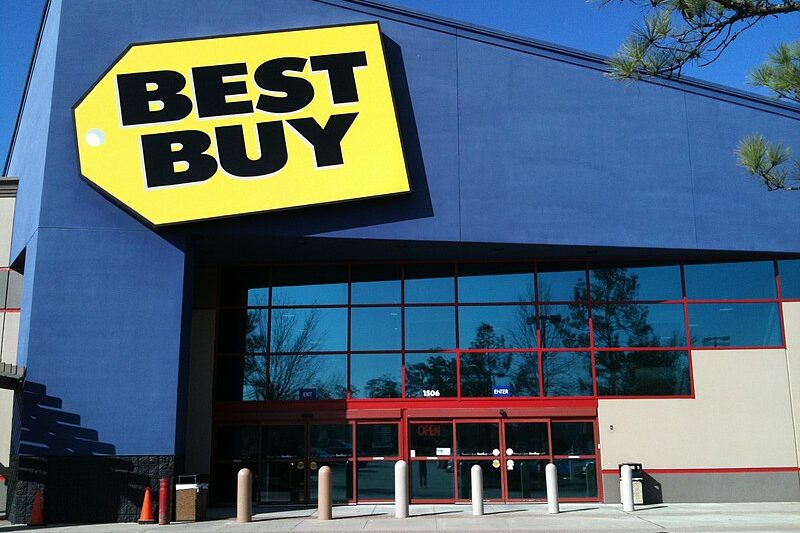The retail landscape is undergoing rapid changes, with major brands scaling back their brick-and-mortar presence to adapt to shifting consumer habits. Online shopping, changing market trends, and economic pressures have forced many once-thriving retailers to downsize significantly. In 2025, several well-known chains will be closing hundreds of stores, marking a continued transformation in the industry.
1. Jo-Ann Stores

Jo-Ann Stores, a beloved retailer for fabric, sewing supplies, and crafts, has struggled to keep up with the rapidly changing retail landscape. The company initially filed for Chapter 11 bankruptcy in early 2024, attempting to restructure its debt and close underperforming stores. However, continued declining foot traffic and growing competition from online retailers like Amazon and specialty craft stores forced Jo-Ann to file for bankruptcy again in early 2025. This time, the company announced the closure of 500 out of its 800 remaining stores, significantly reducing its physical retail presence.
One of Jo-Ann’s biggest challenges has been the rising costs of raw materials and supply chain disruptions, making it harder to maintain competitive pricing. While the COVID-19 pandemic led to a temporary surge in demand for crafting and sewing supplies, that boom faded as consumers returned to pre-pandemic spending habits. Efforts to modernize the company’s online presence and introduce new product lines were not enough to offset declining in-store sales. With these major closures, Jo-Ann faces an uncertain future, though its brand may survive through e-commerce and third-party retail partnerships.
2. Guitar Center

Guitar Center, the largest chain of musical instrument retailers in the U.S., has been struggling with financial instability for years. The company first filed for Chapter 11 bankruptcy in 2020, emerging with a restructured debt plan, but it has continued to face difficulties in adapting to modern retail trends. The rise of direct-to-consumer sales by brands like Fender and Gibson, as well as competition from online platforms like Sweetwater and Reverb, has significantly impacted Guitar Center’s market share. The company’s reliance on brick-and-mortar stores and high lease costs have made profitability challenging in a digital-first economy.
Despite efforts to modernize, including introducing lesson programs and expanding its online inventory, Guitar Center has not been able to recover fully. In 2025, it remains at high risk of another bankruptcy filing, with many locations underperforming. The company’s financial troubles are exacerbated by shifting consumer habits, as more musicians turn to online marketplaces for better deals and direct purchases from manufacturers. If Guitar Center does not make drastic changes to its business model, it could follow in the footsteps of other once-dominant retailers that failed to adapt to the evolving retail landscape.
3. Forever 21

Forever 21, once a dominant force in the fast fashion industry, has struggled to maintain relevance in an increasingly competitive market. After filing for bankruptcy in 2019 and being acquired by Authentic Brands Group, the retailer attempted to rebrand and optimize its store footprint. However, despite these efforts, Forever 21 continues to face declining sales and has recently launched large-scale store-closing sales with discounts of up to 40%. The company’s struggles stem from changing consumer preferences, with shoppers gravitating toward sustainable and higher-quality fashion over disposable fast fashion.
The rise of online competitors like Shein and Fashion Nova has further weakened Forever 21’s position in the market. Many of its physical locations remain oversized and underperforming, making rent costs unsustainable. Additionally, supply chain issues and inflation have put pressure on its pricing model, making it harder for the company to offer the ultra-low prices that once attracted customers. While it has attempted collaborations and social media-driven marketing campaigns, these efforts have not been enough to reverse its downward trajectory. Another bankruptcy filing remains a real possibility in 2025.
4. Nike

Nike, a global leader in athletic wear and footwear, has been closing several of its brick-and-mortar locations as it shifts toward a more digital-focused strategy. In 2024, the company announced the closure of multiple stores, including high-profile locations like its Edinburgh outlet. While Nike remains financially stable overall, its decision to scale back on physical stores reflects the broader industry trend of prioritizing e-commerce and direct-to-consumer sales. The company has been investing heavily in its website and app, offering exclusive product drops and personalized shopping experiences to drive online engagement.
Despite its strong global presence, Nike faces challenges such as rising manufacturing costs, geopolitical tensions affecting supply chains, and increasing competition from brands like Adidas and New Balance. Additionally, the secondhand sneaker market has surged in popularity, leading many consumers to buy limited-edition releases through resale platforms rather than directly from Nike. To stay ahead, the company has focused on sustainability initiatives and innovative designs, but the continued closure of physical stores suggests a shift in retail strategy that could redefine the brand’s future presence in the retail landscape.
5. Dick’s Sporting Goods

Dick’s Sporting Goods has long been a major player in the retail sports and outdoor equipment industry, but it has faced mounting challenges in recent years. In early 2025, the company announced the closure of at least eight stores as part of a strategic overhaul of its business model. The decision follows the company’s acquisition of Moosejaw from Walmart, which was intended to strengthen its outdoor gear segment but has yet to yield significant benefits. With shifting consumer preferences and economic uncertainty, Dick’s is reevaluating its store footprint to focus more on profitable locations and digital expansion.
One of the major hurdles for Dick’s has been increased competition from both specialized retailers and e-commerce giants like Amazon. Additionally, inflation and changing spending habits have led to decreased demand for high-end sporting goods, as many consumers opt for budget-friendly alternatives. While Dick’s has attempted to offset this with loyalty programs and exclusive product lines, store closures indicate that not all locations are performing well. The company is likely to continue its push toward e-commerce and experiential retail to stay competitive in the evolving market.
6. Best Buy

Best Buy, a leader in consumer electronics retail, is reducing its physical store footprint in 2025 as part of a larger shift toward digital sales and streamlined operations. With the rise of e-commerce and the growing preference for online shopping, Best Buy has been adapting its business model to meet the demands of the modern consumer. The company has seen significant growth in online sales, and it is focusing on enhancing its digital experience to remain competitive. As a result, Best Buy will close certain underperforming stores and focus more on its profitable locations.
The closures in 2025 are a reflection of broader industry trends where retailers are rethinking their physical presence in favor of investing in digital tools and improving e-commerce capabilities. Best Buy continues to emphasize services like Geek Squad and its expanded online product offerings, which have helped the company maintain its relevance in a rapidly changing market. By investing more in its digital platform, Best Buy is looking to streamline its operations and position itself for future growth. As it continues to evolve, the company is also expanding its presence in areas like home automation and smart home technology.
7. Party City

Party City, once a go-to retailer for party supplies, balloons, and seasonal decorations, has faced ongoing financial struggles that led to its second bankruptcy filing in December 2024. The company initially filed for Chapter 11 in early 2023, attempting to restructure its debts and optimize store operations. However, declining sales, inflationary pressures, and the increasing shift toward online shopping have made recovery difficult. Party City has struggled to compete with discount retailers like Dollar Tree and Walmart, which offer similar products at lower prices. The bankruptcy filing in late 2024 led to the decision to close all corporate-owned U.S. stores by early 2025, marking the end of an era for the once-popular retailer.
The downfall of Party City can be attributed to several key factors, including changing consumer habits and the post-pandemic decline in large-scale celebrations. Additionally, the cost of helium, which heavily impacts balloon sales, has fluctuated unpredictably, making it harder for Party City to maintain profitability. Attempts to rebrand and introduce more exclusive product lines failed to attract enough customers back to physical stores. Despite the closures, some Party City franchises remain operational, and the brand name may live on in a smaller capacity through licensing agreements.
8. Macy’s

Despite its status as one of America’s most iconic department stores, Macy’s has not been immune to the struggles facing traditional retail. The company has announced plans to shut down several locations in 2025 as part of its ongoing effort to streamline operations. While its flagship stores in high-traffic urban areas remain popular, many suburban locations have struggled with declining foot traffic. Macy’s has been investing heavily in digital sales and smaller, more efficient store formats, but this has not been enough to offset losses in underperforming locations.
The rise of e-commerce and changing shopping behaviors have put significant pressure on the brand. In an attempt to remain relevant, Macy’s has expanded its online presence, introduced new store concepts, and enhanced its loyalty program. However, experts believe that the company will continue to downsize over the next decade. As reported by Retail Wire, Macy’s decision to close stores is part of a broader trend affecting traditional department stores.
9. Kohl’s

Kohl’s, one of the leading department stores in the United States, has been facing significant competition in recent years, particularly with the surge of e-commerce and discount retailers. In response to these pressures, the company has been streamlining its operations and focusing on its most successful stores. As part of this shift, Kohl’s plans to close several locations in 2025. The rise of online shopping and changing consumer habits have forced many brick-and-mortar retailers, including Kohl’s, to adapt to a more digital-first model.
Despite these challenges, the company has made efforts to diversify its offerings, including the addition of more in-store experiences and collaborations with popular brands. Kohl’s also continues to invest in its digital infrastructure, with an emphasis on improving its online shopping experience. This includes expanding its digital marketplace and enhancing its e-commerce fulfillment capabilities. While some stores will close, the company is committed to strengthening its digital presence and catering to the evolving preferences of its customer base. Retail analysts have noted that these closures reflect broader industry trends, where traditional retail businesses are adjusting to the new digital economy.
10. CVS

CVS, a pharmacy and healthcare giant, is undergoing a significant transformation to better align with the changing needs of its customers. In 2025, the company will close a number of its physical locations as part of its strategic shift toward expanding health services and enhancing its digital presence. As consumers increasingly turn to online platforms for shopping, the traditional retail pharmacy model is becoming less effective in certain areas. CVS is responding to this change by focusing on providing more personalized healthcare services and building out its digital capabilities, such as telehealth and prescription delivery.
These efforts reflect the broader trend of pharmacies and healthcare providers increasingly shifting their operations to meet the demand for digital services. The closures in 2025 are part of CVS’s ongoing efforts to streamline its operations, focusing on key locations that are better suited for its new service-driven approach. With an emphasis on expanding health clinics and telemedicine, CVS aims to transform its stores into wellness hubs rather than traditional retail outlets. The company’s future success depends on leveraging both physical locations and its growing online services.
11. Walgreens

Walgreens, another leading pharmacy chain in the U.S., has announced plans to close some of its stores in 2025 as part of a major transformation. The company is pivoting toward a more digital-first approach, focusing on digital health services and providing a more streamlined retail experience. The shift is driven by the growing demand for telemedicine and other digital health solutions, which have become increasingly popular during the COVID-19 pandemic. Walgreens aims to enhance its digital platform by offering virtual consultations and improving its online pharmacy services.
This strategy is in line with broader trends in the healthcare and retail industries, where companies are integrating digital technologies to meet the needs of tech-savvy consumers. The closures of certain stores are part of Walgreens’ efforts to focus its resources on more profitable locations while expanding its health services and digital offerings. By decreasing its reliance on physical stores, Walgreens hopes to create a more efficient business model that can better serve its customers in an increasingly digital world.
12. Gap

Gap, the clothing retailer that also owns Old Navy and Banana Republic, has been reassessing its retail strategy and is set to scale back its physical store presence in 2025. The company is focusing on its most successful locations while enhancing its online shopping experience. Over the years, Gap has faced growing competition from fast fashion brands, online retailers, and changing consumer preferences. As a result, the company is shifting its focus to e-commerce, investing in its digital infrastructure to better compete in the ever-evolving retail market.
By consolidating its store locations and prioritizing high-performing areas, Gap aims to maintain profitability in an increasingly challenging landscape. The closures in 2025 reflect a broader trend in the retail industry, where many companies are shifting their focus from physical stores to digital-first models. While the company plans to reduce its brick-and-mortar footprint, it will continue to invest in the growth of its online presence, offering an improved customer experience through its e-commerce platform. Gap’s strategy includes enhancing its digital marketing efforts and improving supply chain efficiency to meet the growing demand for online shopping.
13. JCPenney

JCPenney has been a fixture in American shopping malls for decades, but the rise of e-commerce and shifting consumer habits have placed it in jeopardy. The retailer has attempted multiple turnaround strategies, including store redesigns, updated branding, and a focus on online sales, but these efforts have yielded mixed results. In 2025, JCPenney is set to close numerous underperforming locations in an effort to consolidate its operations. The closures come as part of the company’s broader strategy to focus on its most profitable stores while reducing overall operating costs.
Despite some success with its online expansion, JCPenney has struggled to regain the loyal customer base it once had. The competition from retailers like Amazon, Target, and fast-fashion brands has further contributed to its decline. Analysts predict that JCPenney will continue to shrink in size over the coming years, and its long-term future remains uncertain. JCPenney’s recent closures are part of an industry-wide shift away from traditional department stores.
